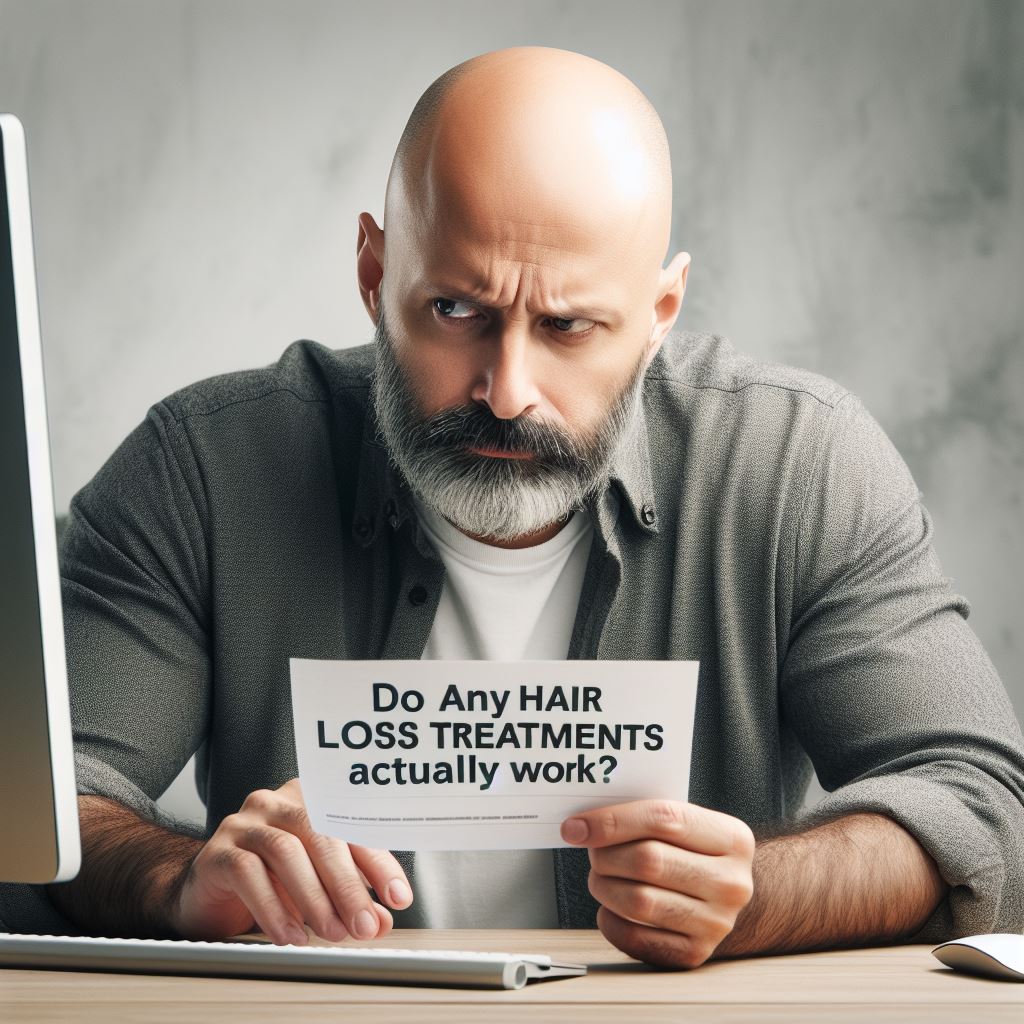There are a lot of hair loss treatments on the market, but do any of them actually work? That’s a question that many people ask, and unfortunately, there is no easy answer. While there are some treatments that can help to slow down hair loss or even promote new growth, there is no guarantee that they will work for everyone. Ultimately, the best way to determine if a hair loss treatment is right for you is to consult with a dermatologist or other medical professional who can give you personalized advice.
Why is your hair thinning?
There are a variety of factors that can contribute to thinning hair. Genetics plays a major role, as individuals with a family history of hair loss are more likely to experience thinning hair themselves. Hormonal changes, such as those that occur during pregnancy, menopause, or thyroid imbalances, can also lead to hair thinning. Certain medical conditions, such as alopecia areata or trichotillomania, can cause hair loss as well.
Additionally, poor nutrition, high-stress levels, and excessive styling or heat damage can also contribute to thinning hair. Environmental factors, such as exposure to pollutants and toxins, can also play a role in hair thinning. It’s important to understand the specific underlying cause of your thinning hair in order to properly address it, so consulting with a dermatologist or hair specialist is advisable. They can help determine the cause and recommend the appropriate treatment options to help manage or reverse the thinning.

Where to turn for hair loss help
If you are experiencing hair loss and don’t know where to turn for help, there are a few options to consider. Firstly, it’s a good idea to schedule an appointment with a dermatologist or trichologist, as they specialize in the health of the skin and hair. They can help diagnose the cause of your hair loss and recommend treatments or solutions tailored to your specific needs.
Another option is to consult with a hair transplant specialist, who can provide information on surgical options for restoring hair growth. Additionally, some hair salons and beauty clinics offer non-surgical hair loss treatments, such as laser therapy or scalp micro-pigmentation.
It’s important to do your research and consult with a professional to determine the best course of action for addressing your hair loss concerns. Don’t be afraid to seek out support and guidance from experts in the field, as there are many options available for managing and treating hair loss.
Do KEEPS Hair Loss Treatments Really Work?
Hair loss treatments abound, but do any of them actually work? That’s the question many people ask, and unfortunately, there is no easy answer. While there are a number of potential treatments out there, their effectiveness can vary greatly from person to person.
What works for one person may not work for another, and what works today may not work tomorrow. That said, there are a few hair loss treatments that seem to be more effective than others. Minoxidil ( Rogaine ) is one of the most popular hair loss treatments on the market today, and it has been shown to be effective in both men and women.
Another treatment that shows promise is finasteride ( Propecia ), which is typically used to treat male pattern baldness . If you’re struggling with hair loss , it’s important to consult with a dermatologist or other medical professional who can help you determine which treatment option may be right for you.
Regrow Hair Naturally in 3 Weeks
Are you looking for a way to regrow hair naturally? If so, you’re not alone. Millions of people suffer from hair loss each year, and many of them are searching for natural solutions. Hair loss can be caused by a variety of factors, including genetics, illness, stress, and diet. Fortunately, there are a number of things you can do to promote hair growth and prevent further hair loss. Here are some tips to help you regrow hair naturally:
1. Eat a healthy diet. Eating plenty of fresh fruits and vegetables is essential for good health and strong hair. Be sure to include foods like salmon, nuts, and avocados in your diet as well. These foods contain nutrients that are essential for healthy hair growth.
2. Get regular exercise. Exercise is not only good for your overall health, but it can also help improve blood circulation to the scalp, which is important for healthy hair growth.
3 . Reduce stress levels. Stress can contribute to hair loss, so it’s important to find ways to relax and de-stress yourself on a daily basis. Try yoga or meditation, take walks in nature, or get regular massages. All of these activities can help reduce stress levels and promote healthy hair growth.
4 Avoid harsh chemicals. Many shampoos, conditioners, and styling products contain harsh chemicals that can damage your scalp and hair follicles. Choose natural haircare products whenever possible to avoid exposure to these harmful ingredients.
5 Limit heat exposure Heat styling tools like curling irons and blow dryers can damage your hair and lead to breakage. If you must use heat styling tools, be sure to use them on the lowest setting possible, and always use a heat protectant spray before applying any heat.
6 Get enough sleep getting proper rest is crucial for good health overall, but it’s also important for maintaining healthy hair.

Credit: www.healthline.com
Are Hair Loss Treatments Worth It?
Hair loss treatments can be a great way to improve the appearance of thinning hair, but they’re not for everyone. Here’s what you need to know before trying one. Hair loss treatments can help improve the appearance of thinning hair, but they’re not for everyone.
Before trying a hair loss treatment, it’s important to understand the potential risks and benefits. There are two main types of hair loss: genetic and acquired. Genetic hair loss is caused by factors that are out of your control, such as your genes or hormones. Acquired hair loss can be caused by factors like stress, illness, or certain medications. If you’re considering a hair loss treatment, it’s important to talk to your doctor about the cause of your hair loss. This will help you determine if a treatment is right for you.
There are many different types of hair loss treatments available, including Rogaine (minoxidil), Propecia (finasteride), laser therapy, and surgery. Rogaine and Propecia are FDA-approved medications that are effective at slowing down or stopping hair loss in most people. Laser therapy and surgery are more invasive options that may be recommended in some cases.
Hair loss treatments can have side effects, so it’s important to weigh the pros and cons before starting any type of treatment. In general, the risks associated with hair loss treatments are low when compared to the potential benefits. However, every person is different, and you should discuss the risks and benefits with your doctor before starting any treatment.
Are There Any Permanent Hair Loss Solutions?
Yes, there are a few permanent hair loss solutions available. The most common and effective solution is hair transplant surgery. This procedure involves taking healthy hair follicles from other parts of the body and grafting them onto the balding areas.
Hair transplants can be very successful in restoring hair growth and density. However, they are also expensive and require multiple sessions to achieve desired results. Another permanent solution for hair loss is scalp micro pigmentation (SMP).
This treatment involves injecting pigment into the scalp to create the illusion of fuller, thicker hair. SMP can be an excellent option for those who do not want or cannot have surgery. It is also less expensive than transplants and requires only a single session.

Can Hair Grow Back After Thinning?
Yes, hair can grow back after thinning, although the extent of regrowth can vary from person to person. There are several factors that can contribute to hair thinning, such as genetics, hormonal imbalances, stress, and poor nutrition. Addressing these underlying causes can help promote hair regrowth.
Additionally, using hair growth products and treatments, such as minoxidil or finasteride, may also aid in stimulating hair regrowth. It’s important to note that it may take time for noticeable results to occur, and consistency with any treatment is key. In some cases, individuals may also consider hair transplant procedures to restore lost hair.
Overall, while it is possible for hair to grow back after thinning, it is important to consult with a healthcare professional and explore the best options for promoting hair regrowth based on individual needs and circumstances. Patience, proper care, and seeking expert advice can all play a part in regaining thicker, fuller hair.
Frequently Asked Questions [FAQs]
What causes hair loss?
Hair loss can be caused by a variety of factors, including genetic predisposition, hormonal changes, medical conditions, medications, stress, poor nutrition, and certain hairstyles or treatments. It’s important to consult with a healthcare provider to determine the specific cause of hair loss and the most suitable treatment options.
Do hair loss treatments actually work?
Yes, some hair loss treatments have been clinically proven to slow down hair loss and even promote new hair growth in certain cases. The effectiveness of a hair loss treatment can depend on the cause of the hair loss, the specific treatment used, and individual factors such as age, general health, and adherence to the treatment protocol.
What are the most effective treatments for hair loss?
The most effective treatments for hair loss include medications such as minoxidil (Rogaine) and finasteride (Propecia), which are FDA-approved for hair loss treatment. Other treatments, such as low-level laser therapy (LLLT), platelet-rich plasma (PRP) therapy, and hair transplant surgery, may also be effective for some individuals.
What are the potential side effects of hair loss treatments?
Potential side effects of hair loss treatments can vary depending on the specific treatment used. For example, minoxidil may cause scalp irritation or unwanted hair growth on other parts of the body, while finasteride may cause sexual side effects such as reduced sexual desire or erectile dysfunction. It’s important to discuss potential side effects with a healthcare provider before starting a hair loss treatment.
How long does it take for hair loss treatments to work?
The time it takes for hair loss treatments to work can vary, but generally, it takes at least several months to see noticeable improvements. For some treatments, it may take up to a year or more. It’s important to be patient and consistent with the treatment for the best results.
Conclusion
The short answer is: maybe. While there are a lot of hair loss treatments out there that claim to be effective, the reality is that most of them don’t have any scientific evidence to back up their claims. That said, there are a few treatment options that have been shown to be effective in some cases.
The most common and well-known hair loss treatment is minoxidil, which is available over the counter as Rogaine. Minoxidil has been shown to be effective in slowing down hair loss and promoting new hair growth in some people, but it doesn’t work for everyone. Another option is finasteride, which is a prescription medication that can also slow down hair loss and promote new hair growth.
